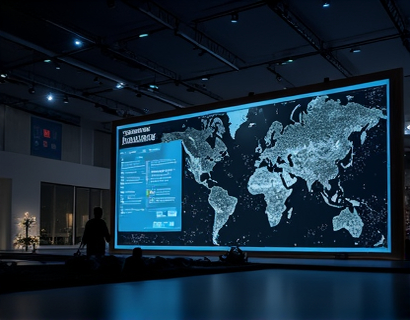Revolutionizing Global Connectivity: Harnessing Advanced Distributed Networks for Enhanced Business Communication and Operations
In the rapidly evolving landscape of global business, the need for robust, efficient, and reliable communication networks has never been more critical. Traditional networking solutions often fall short in meeting the demands of modern enterprises, especially those with a global footprint. This article delves into the transformative potential of advanced distributed networks, exploring how these technologies can revolutionize business communication and operations. By understanding the core principles and benefits of distributed networking, organizations can better position themselves to thrive in an interconnected world.
Understanding Distributed Networks
Distributed networks are architectures where computing resources and data storage are spread across multiple nodes or locations, rather than being centralized in a single server or data center. This decentralized approach offers several advantages over traditional centralized models. One of the primary benefits is enhanced reliability. Since data and processes are distributed across multiple nodes, the failure of a single node does not bring down the entire system. This redundancy ensures continuous operation and minimizes downtime, which is crucial for businesses that cannot afford interruptions.
Another significant advantage of distributed networks is improved performance. By placing computing resources closer to the end-users, data transfer times are reduced, leading to faster response times and a more seamless user experience. This is particularly important for global businesses that serve customers across different time zones and geographic regions. The reduced latency not only enhances user satisfaction but also improves the efficiency of business operations.
Enhancing Business Communication
Effective communication is the backbone of any successful organization, and distributed networks play a pivotal role in facilitating seamless communication across global teams. Traditional communication tools often struggle with latency and bandwidth limitations, especially when dealing with large volumes of data or real-time interactions. Distributed networks, however, are designed to handle these challenges with ease.
For instance, video conferencing, a critical tool for remote teams, benefits immensely from low-latency connections provided by distributed networks. High-definition video streams can be transmitted without delays or interruptions, ensuring that remote participants feel as if they are in the same room. Additionally, file sharing and collaborative tools can operate more efficiently, allowing teams to work together in real-time without the hassle of slow uploads or downloads.
Moreover, distributed networks support the integration of advanced communication technologies such as Internet of Things (IoT) devices and real-time data analytics. IoT devices can send and receive data seamlessly, enabling businesses to monitor and manage operations in real-time. This level of connectivity is essential for industries like manufacturing, logistics, and healthcare, where timely data is crucial for decision-making and operational efficiency.
Streamlining Business Operations
Beyond communication, distributed networks offer comprehensive solutions for streamlining various business operations. One of the key areas is data management. With distributed networks, organizations can store and process data closer to where it is generated, reducing the load on central servers and improving data access speeds. This decentralized data management approach not only enhances performance but also enhances security. Data is less vulnerable to breaches and cyber-attacks, as it is not concentrated in a single point of failure.
Another operational benefit is the ability to scale resources dynamically. Distributed networks can automatically allocate computing resources based on real-time demand, ensuring that businesses can handle peak loads without over-provisioning. This elasticity is particularly valuable for companies with fluctuating workloads, such as e-commerce platforms during sales events or content delivery networks during peak viewing times.
Furthermore, distributed networks facilitate the deployment of edge computing, which involves processing data at the edge of the network, closer to the source of data generation. Edge computing reduces the need to send large amounts of data to central data centers, further decreasing latency and bandwidth usage. This is especially beneficial for applications requiring immediate responses, such as autonomous vehicles, smart cities, and augmented reality experiences.
Case Studies and Real-World Applications
To better understand the practical implications of distributed networks, let's explore a few real-world applications across different industries.
In the financial sector, distributed networks have been instrumental in enhancing transaction processing and security. Banks and financial institutions use these networks to perform high-frequency trading and real-time risk assessments. The low latency and high reliability of distributed networks ensure that transactions are processed swiftly and securely, reducing the risk of errors and fraud.
The healthcare industry has also seen significant improvements through the adoption of distributed networks. Electronic health records (EHRs) can be stored and accessed from multiple locations, ensuring that medical professionals have immediate access to patient data regardless of their location. This not only improves patient care but also enhances the coordination between different healthcare providers.
In the retail sector, distributed networks enable seamless omnichannel experiences. Customers can browse products online and pick them up in-store, or return items purchased online in physical stores. The real-time synchronization of inventory and customer data across all channels is made possible by distributed networks, providing a cohesive and efficient shopping experience.
Challenges and Considerations
While the benefits of distributed networks are clear, there are several challenges and considerations that organizations must address when implementing these solutions.
One of the primary challenges is the complexity of setting up and managing a distributed network. Unlike traditional centralized systems, distributed networks require a more sophisticated architecture and expertise to ensure optimal performance and security. Organizations need to invest in skilled personnel or partner with experts who can design and maintain these systems effectively.
Another consideration is the initial cost of deployment. While distributed networks can lead to long-term cost savings through improved efficiency and reduced downtime, the upfront investment can be significant. Organizations must conduct a thorough cost-benefit analysis to ensure that the benefits justify the expenses.
Security is also a critical concern. Although distributed networks can enhance security by reducing single points of failure, they also introduce new vulnerabilities. Ensuring end-to-end encryption, implementing robust access controls, and regularly monitoring network activity are essential to maintaining the integrity of the network.
Future Trends and Innovations
The landscape of distributed networks is continually evolving, with several emerging trends and innovations poised to further enhance global connectivity and business operations.
One such trend is the integration of blockchain technology with distributed networks. Blockchain's inherent properties of transparency, immutability, and decentralization align well with the principles of distributed networking. This combination can lead to more secure and transparent transactions, particularly in industries like supply chain management and finance.
Another area of innovation is the use of artificial intelligence (AI) and machine learning (ML) to optimize distributed networks. AI can analyze vast amounts of data to predict network behavior, identify potential bottlenecks, and automate resource allocation. This intelligent management ensures that networks operate at peak efficiency, adapting to changing demands in real-time.
Additionally, the rise of 5G and beyond technologies will further enhance the capabilities of distributed networks. The increased bandwidth and reduced latency of 5G networks will enable even more sophisticated applications and services, from smart cities to advanced industrial automation.
Conclusion
In conclusion, advanced distributed networks represent a transformative force in the realm of global business communication and operations. By offering enhanced reliability, performance, and security, these networks empower organizations to expand their reach, optimize their processes, and stay competitive in a rapidly changing world. While there are challenges to consider, the benefits of distributed networks make them an invaluable asset for businesses looking to thrive in the digital age.










































